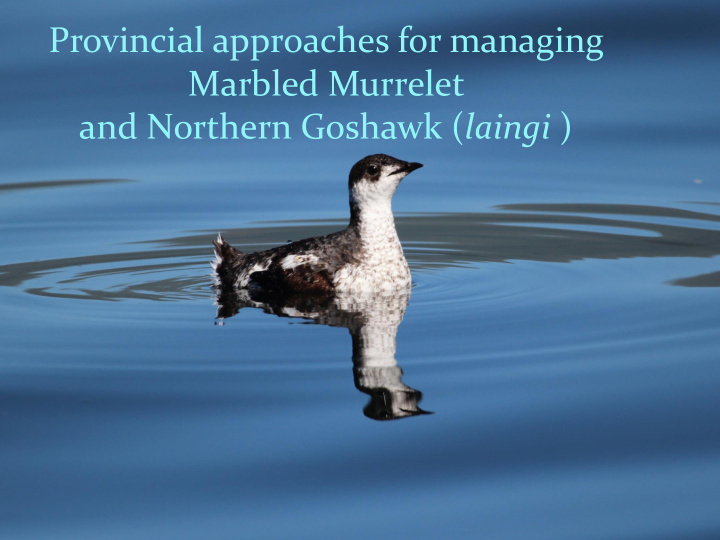



Provincial approaches for managing Marbled Murrelet and Northern Goshawk ( laingi )
Purpose of Presentation Why prepare Implementation Plans? Share information re: proposed provincial management approach for MAMU and NOGO Review next steps, timelines
Review: Implementation Plans Seek to meet commitments in the Accord for the Protection of Species at Risk in Canada and the Canada - British Columbia Agreement on Species at Risk; Guide management actions; Informed by science; Consider socio-economic factors. Represent a formal government commitment
MAMU Key Decision Points Key Decision Point 1: MAMU Minimum Habitat Thresholds (Thresholds) and Distribution Key Decision Point 2: The Extent of Spatial and Aspatial Management
Proposed approach for MAMU Seeks to achieve expectations of Canada’s strategy on provincial Crown land; Includes: Completion of existing land use planning; By 2017, protect specified amounts of habitat in all Conservation Regions; Combines spatial and aspatial approaches.
MAMU Habitat Thresholds and Distribution Proposed approach: Adopt updated Minimum Habitat Thresholds (MHTs) and Conservation Region (CR) distribution as outlined in the 2014 Federal MAMU Recovery Strategy applied to Crown land only
Proposed Provincial approach Northern Central West & North Eastern South Alaska Total Haida Mainland Mainland Vancouver Vancouver Coast Border Area Gwaii Coast Coast Island Island (85%) (70%) (70%) (68%) (68%) (68%) (68%) (90%) All 293,242 150,315 229,577 103,468 179,893 71,700 19,018 1,047,213 Lands Crown 265,872 148,529 228,962 97,391 173,467 25,863 19,013 959,096 Land
MAMU Extent of Spatial and Aspatial Management Proposed approach: Spatialize and legalize 80% of the total suitable habitat in the WNVI and SMC CRs Explore opportunities to spatialize functional habitat on EVI with affected parties (e.g. PMFL holders).
Proposed Provincial Management Approaches for Northern Goshawk, laingi (NOGO ) R. Hill
Summary of Proposed approach for NOGO Key Decisions: 1) Home Range Targets and Distribution 2) Breeding Area size Define foraging habitat management by 2020.
Breeding Area Management Proposed approach is to manage Breeding Areas by design, not discovery Management by design: • Maximizes conservation outcomes • Mitigates socio-economic impacts Key aspect of Implementation Plan Not proposing to adopt the Critical Habitat on the list of 108 home ranges
NOGO – Key Decision 1 Home Range Targets and Distribution Proposed approach is to adopt the revised federal home range targets and distribution with the exception of Haida Gwaii 408 home ranges overall
NOGO – Key Decision 1 Home Range Targets and Distribution Vancouver Island South Coast North Coast Haida Gwaii Total Home Conservation Conservation Conservation Conservation Ranges Region Region Region Region Original Federal 184 122 80 58 444 Home Range Targets Original Provincial 184 122 80 25 411 Home Range Targets Revised Federal 145 110 128 58 441 Home Range Targets Recommended Revised 145 110 128 25 408 Provincial Home Range Targets
NOGO – Key Decision 2 Breeding Area (BA) Size Set a target size of 200 ha of suitable habitat for each BA reserve with a minimum size of 176 ha around all known nests. Provides more management flexibility compared to a fixed 200 ha reserve size Increases number of BAs that can contribute to objectives
Foraging Habitat management Variability in foraging habitat requirements Challenge translating science into management Potential for significant socio-economic impacts Decision deferred until 2020 Research plan being developed Pursuing additional analyses/ modelling Actions to be included in I.P.
Comparison of BC’s proposed plan with Canada’s (NOGO): Except Haida Gwaii, BC adopts federal home range targets and distribution. Does not adopt Critical Habitat on all 108 home ranges identified in federal strategy. Management by design (vs. by discovery). Proposes low-risk management approach (200 ha target and 176 ha minimum) for Breeding Areas that contribute to population objectives Small deviation from federal formula Decision on foraging habitat management deferred until 2020 (research plan and other analyses)
Ongoing work (NOGO) Inventory and Monitoring to support new WHAs UBC/ Genome BC genomic research Shared stewardship discussions on non-Crown land (Private Managed Forest Land and First Nations) Implementation Plan target: ~June 2017 Breeding Area management ‘by design’ Transition Zone Foraging habitat research plan and analyses by 2020
NEXT STEPS: Legalize draft OGMAs with high suitability MAMU habitat Finalize works in progress (i.e. priority WHAs for both species) enabled by CFPA MOU Continued inventory and monitoring Explore shared stewardship on non-Crown land Develop Implementation Plans (target: June 2017) including continued engagement with CFPA et al.
Recommend
More recommend